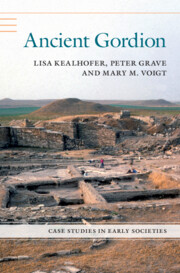Book contents
- Ancient Gordion
- Case Studies in Early Societies
- Ancient Gordion
- Copyright page
- Contents
- Acknowledgments
- Abbreviations
- 1 Introduction
- 2 Inventing Identity
- 3 Contextualizing the Ceramic Assemblage
- 4 Identifying Gordion’s Groups
- 5 The Late Bronze Age Community at Gordion
- 6 Reconstituting Community in the Early Iron Age
- 7 New Identities, New Communities
- 8 Enacting Power
- 9 Identities in Flux
- 10 Conclusion
- Appendix Eski Çağ’da Gordion:
- References
- Index
7 - New Identities, New Communities
The Early Phrygian Period YHSS 6 900–800 BCE
Published online by Cambridge University Press: 23 September 2022
- Ancient Gordion
- Case Studies in Early Societies
- Ancient Gordion
- Copyright page
- Contents
- Acknowledgments
- Abbreviations
- 1 Introduction
- 2 Inventing Identity
- 3 Contextualizing the Ceramic Assemblage
- 4 Identifying Gordion’s Groups
- 5 The Late Bronze Age Community at Gordion
- 6 Reconstituting Community in the Early Iron Age
- 7 New Identities, New Communities
- 8 Enacting Power
- 9 Identities in Flux
- 10 Conclusion
- Appendix Eski Çağ’da Gordion:
- References
- Index
Summary
Over the course of the ninth century BCE Phrygia emerged as an influential power in central Anatolia (Fig. 7.1). At the Phrygian capital of Gordion, groups created entirely new social and political configurations, elaborating and displaying status in ways that contrasted sharply with their Bronze Age and EIA predecessors. The territorial extent of Phrygia has been defined using multiple lines of evidence. Material evidence for the range of Phrygian influence includes strong ceramic parallels with pottery at sites to the southeast (Bahar 1999; Osborne 2020), as well as the distribution of monuments and inscriptions at least as far west as Daskyleion (DeVries 2000). Historical data for the Halys River (modern Kızılırmak) area in the east suggest the presence of a complex political palimpsest of multiple competing polities (Sams 2011a). By the late seventh century BCE both ceramics and Phrygian inscriptions at the fortified hilltop site of Kerkenes indicate Phrygian influence extended at least this far east (Summers 2018), but we know little about the ninth and eighth centuries BCE in this area. However, geographic delineation of Phrygia has not advanced understanding of the organization and practices of Phrygian power, arguably major drivers of political expansion at this time. In this chapter, we consider the Phrygian capital Gordion and the daily practices of local groups as a foundation for addressing Phrygian practices of power.
- Type
- Chapter
- Information
- Ancient Gordion , pp. 171 - 226Publisher: Cambridge University PressPrint publication year: 2022



